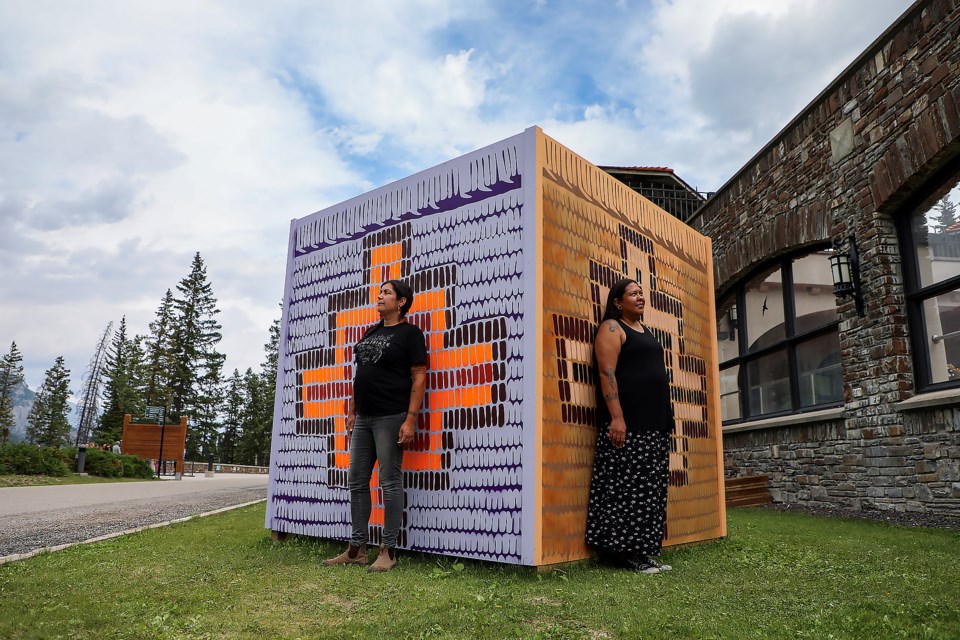BANFF – Tania Willard’s story of this place starts with a basket.
While exploring the Whyte Museum of the Canadian Rockies’ collections in May, the Secwépemc artist found inspiration in a cedar root basket much like the ones she studies from her own First Nation and others in B.C.
“This was a really beautiful, dramatic design and I think deeply about some of these ideas embedded in that medium,” said Willard.
“I drew every single stitch from that basket from the original, from a photograph, and made that into a stencil.”
The artist spray-painted the stencil, on an eight-by-eight foot finished aluminum box on the grounds of the Cave and Basin National Historic Site.
The mural and two others, by Ktunaxa artist Lillian Rose and Métis artist Brandon Atkinson, are part of a collaboration with Parks Canada and the Whyte Museum to share the stories of Indigenous peoples connected to Banff National Park.
Indigenous peoples have inhabited the area in the present-day park for over 10,000 years. Before the arrival of European settlers, they had robust trade networks spanning hundreds of kilometres, facilitating the movement of people, goods, services and ideas.
Willard, who is also a practicing curator and art instructor at the University of British Columbia, said the basket – in many ways – symbolizes the shared connection many Indigenous peoples have to the area.
There was an understanding by Indigenous peoples on both sides of the Rocky Mountains that the area was a shared space. In 1895, the Ktunaxa, Stoney Nakoda, and Secwépemc reached an agreement affirming their mutual rights to harvest resources on each side of the mountains.
Willard said the cedar root basket is a “way of connecting to exchange and movement and art form.”
While to many a basket may seem like just a place to store stuff, they hold much more value to those who understand their origins and the knowledge it takes to make one.
“When you don’t know the background to something it’s easy to sort of dismiss it as an object – like a basket’s just a basket – why should we be interested?” said Willard.
“But actually, there are deep philosophies and Indigenous ways of being that are encoded into that cedar root basket. A storage basket is what it may be labelled as, but I think of it as storing Indigenous knowledge, ways of being and interconnection. So, it’s a different kind of data storage.”
Dawn Saunders Dahl, project lead and Whyte Museum Indigenous relations and programs manager, said other artists murals explored similar connections with wildlife and environment.
Rose’s piece features a buffalo on one side of the box, with salmon and roe on another panel.
“Part of her artist statement explores this disconnect with colonialism and the impact of loss of bison the [the Ktunaxa] would once trade with the Stoney Nakoda,” said Saunders Dahl.
In Atkinson’s mural, he pays respect to Banff’s two most famous bears No.122 and No.136.
“He has all these kinds of stories and connections to place on part of the mural with a medicine wheel, and then on the other side, he has Split Lip and The Boss, and the other panel is for Parks,” said Saunders Dahl.
“He said he was really grateful to be one of the artists selected and wanted to pay homage to these two great bears because he had a lot of great chats with Parks staff. In his pen and ink jar style, there’s so much detail in these bears, there’s so much detail of all these connections to this park and to the mountains and the animals here.”
Saunders Dahl said the project is largely an effort on Parks Canada’s part, in partnership with the Whyte, to act on truth and reconciliation. It includes a mentorship aspect with Edmonton street artist AJA Louden, and lessons on how to access archives for historical reference and inspiration, and ensuring artists understand their rights as artists – to be paid and treated fairly.
“Not a lot of folks know what the Whyte Museum or what Parks Canada is doing to help engage with Indigenous artists and community members in a wiser way,” she said.
“I hope that we’re leading by good example. It’s important for Indigenous artists to have these opportunities – there are so many talented folks but so many who don’t get an opportunity like this.”
The murals will be on display on the grounds of the Cave and Basin until winter, when they’ll be tucked away for storage and brought back out again next summer.
This is the second mural project Parks and the Whyte have collaborated on at the site and Saunders Dahl said they plan to run it again next summer, with a call out to other Indigenous artists likely going out before the new year.
The Local Journalism Initiative is funded by the Government of Canada. The position covers Îyârhe (Stoney) Nakoda First Nation and Kananaskis Country.



